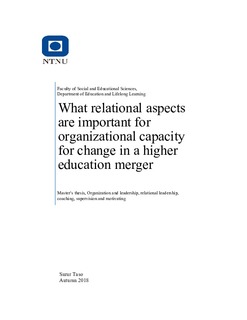| dc.description.abstract | Background: Organizational change in today’s society is becoming commonplace. For many organizations, this means that they either change the way they do business and create value or perish. This trend and necessity for change is influencing higher education, which has seen considerable re-structuring in the past twenty years. Although there is extensive research and literature on organizational change in corporations, there is insufficient research on managing organizational change and organizational capacity for change in higher education. The Norwegian government initiated different mergers as a measure for restructuring the higher education sector. These initiatives aimed to improve efficiency and quality at the institutions. Therefore, I choose to fill the gap by investigating: “What relational aspects are important for organizational capacity for change in higher education mergers?”
Methods: To answer this question, I used qualitative methodology and a holistic case study of a merger of my workplace, the Norwegian University of Science and Technology (NTNU) with three colleges, Høgskolen i Sør-Trøndelag (HIST), Høyskolen i Gjøvik (HiG) and Høyskolen i Ålesund (HiÅ). As the merger and change implementation is still ongoing, I chose to use documents as data and performed a theme analysis. I made a search of articles produced by the University newspaper, Universitetsavisa (UA) and others, for three stages of the merger (2014-2017), pre- merger, the merger and post-merger stage. In addition, I used different decision-making documents and evaluations, performed by Deloitte (2015) and Nordic Institute for Studies in Innovation, Research and Education (NIFU, 2016), at different points of the merger. These reports express the status quo at the time when performed and do not comment or discuss specifically the merger partners’ OCC.
Merger characteristics: There are four significant characteristics for the possible outcomes of this change, the merging organizations are of different size, located in three different cities, have different focus when it comes to research and education, and have employees with a diverse academic background. The thesis’ main contribution has thus been on what aspects and actions leaders focus on to express organizations’ goals for organizational change, how they involve staff and adapt resources to a merger, and thereby influence OCC. | nb_NO |
